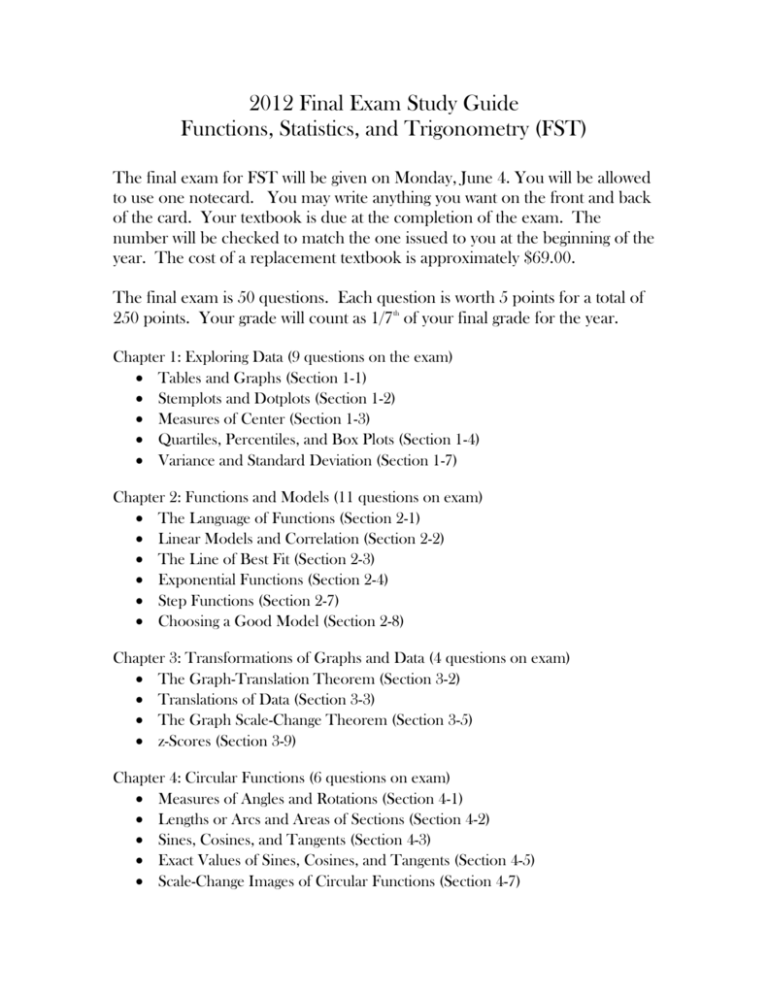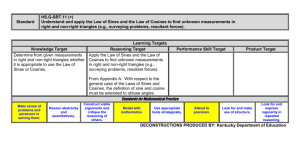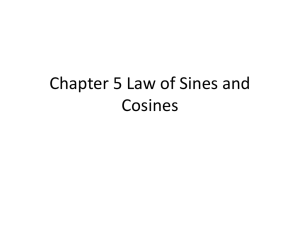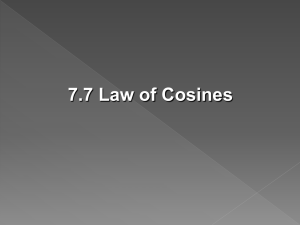Final Exam Study Guide
advertisement

2012 Final Exam Study Guide Functions, Statistics, and Trigonometry (FST) The final exam for FST will be given on Monday, June 4. You will be allowed to use one notecard. You may write anything you want on the front and back of the card. Your textbook is due at the completion of the exam. The number will be checked to match the one issued to you at the beginning of the year. The cost of a replacement textbook is approximately $69.00. The final exam is 50 questions. Each question is worth 5 points for a total of 250 points. Your grade will count as 1/7th of your final grade for the year. Chapter 1: Exploring Data (9 questions on the exam) Tables and Graphs (Section 1-1) Stemplots and Dotplots (Section 1-2) Measures of Center (Section 1-3) Quartiles, Percentiles, and Box Plots (Section 1-4) Variance and Standard Deviation (Section 1-7) Chapter 2: Functions and Models (11 questions on exam) The Language of Functions (Section 2-1) Linear Models and Correlation (Section 2-2) The Line of Best Fit (Section 2-3) Exponential Functions (Section 2-4) Step Functions (Section 2-7) Choosing a Good Model (Section 2-8) Chapter 3: Transformations of Graphs and Data (4 questions on exam) The Graph-Translation Theorem (Section 3-2) Translations of Data (Section 3-3) The Graph Scale-Change Theorem (Section 3-5) z-Scores (Section 3-9) Chapter 4: Circular Functions (6 questions on exam) Measures of Angles and Rotations (Section 4-1) Lengths or Arcs and Areas of Sections (Section 4-2) Sines, Cosines, and Tangents (Section 4-3) Exact Values of Sines, Cosines, and Tangents (Section 4-5) Scale-Change Images of Circular Functions (Section 4-7) Translation Images of Circular Functions (Section 4-8) The Graph-Standardization Theorem (Section 4-9) Chapter 5: Trignometric Functions (3 questions on exam) The Law of Cosines (Section 5-2) The Law of Sines (Section 5-4) General Solutions to Trigonometric Equations (Section 5-7) Chapter 6: Root, Power, and Logarithm Functions (5 questions on exam) Logarithm Functions (Section 6-3) e and Natural Logarithms (Section 6-4) Properties of Logarithms (Section 6-5) Solving Exponential Equations (Section 6-6) Chapter 7: Probability and Simulation (5 questions on exam) Basic Principals of Probability (Section 7-1) Additional Counting Principals (Section 7-2) Multiplication Counting Principals (Section 7-3) Permutations (Section 7-4) Independent Events (Section 7-5) Probability Distributions (Section 7-6) Chapter 8: Sequences, Series, and Combinations (2 questions on exam) Formulas for Sequences (Section 8-1) Arithmetic Series (Section 8-3) Chapter 9: Polynomial Functions (5 questions on exam) Graphs of Polynomial Functions (Section 9-2) Division and the Remainder Theorem (Section 9-4) Complex Numbers (Section 9-6) The Fundamental Theorem of Algebra (Section 9-7) This should give you a good idea of the key areas from which the questions were chosen. However, there is still a possibility that a couple questions could come from sections not mentioned.








